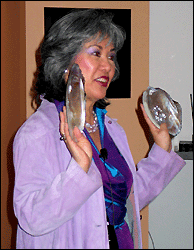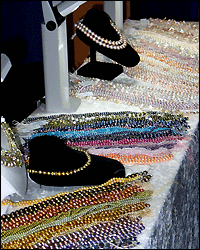
A capacity audience at GIA listened with rapt attention as "Pearl Goddess" Betty Sue King revealed the magnificence of exotic pearls during her presentation March 20. King's address, Pearls, kicked off the 2003 lecture series hosted by the GIA Museum. This year's series, "Color Perspectives," is dedicated to color in gems, and King's lecture was the first in four to be presented.
King, a pearl industry specialist who has owned a pearl wholesaling business for 24 years, took the audience on an enchanting odyssey of pearls. She defined the role that pearls have played throughout history, and discussed their lore, sources, formation, and how they are brought to the market.
In opening the lecture, King said, "I will explain how pearls evolved from simple objects of admiration to a prized and revered part of human culture and adornment." King said that natural pearls were originally discovered around a million years ago, and at that time were appreciated for their beauty alone.
Later, pearls evolved into symbolic figures, and were presented as evocative gifts dating as far back as 2206 B.C. during the time of Confucius. King depicted the myth of the Polynesian God Oro (God of peace and fertility), who, it is said, came to earth on a rainbow to offer a pearl as a symbol of love to the princess of Bora Bora. King also referred to the Roman and Greek legends of Venus/Aphrodite (Goddess of love, beauty and pleasure), who came out of the sea with water droplets turning into pearls, holding all the "charms" of the love goddess.
Pearls developed into ecclesiastical eminence, and later were popularized by prominent monarchs. King presented images of a 16thcentury Russian icon of Madonna and Child lavished with pearls. King said Queen Elizabeth I was the most avid pearl lover in history, and she showed the "Fairy Queen Portrait," (1550s - 1603) depicting the queen adorned in one of her 300 gowns that were laden, set, and sewn with natural pearls. "More than simple objects of beauty, she considered pearls indispensable to her appearance of regal strength," said King.
By the early 1900s the worldwide demand for natural pearls exceeded the supply, leading to the development of cultured pearls by Kokichi Mikimoto. King said the industry reacted with staunch resistance at first.

In the 1930's, designer Coco Chanel paved the way for the wide acceptance of cultured pearls. King said, "She often wore them like costume jewelry, mixing them without any thought to whether they were faux, natural or cultured. Thanks to Chanel, the pearl strand has defined classic women's fashion." It wasn't until 1955 when Tiffany & Co. acquiesced to this growing demand. Others like Marilyn Monroe and Elizabeth Taylor also often dressed in sumptuous pearls.
Since then, cultured pearls have gained exceptionally wide fondness. In the 1980s great strides were made in the production of larger numbers of cultured pearls from China, said King. She emphasized the recent improvements in the quality and size of Chinese freshwater cultured pearls, and pointed out the rich color variations offered in today's market. "China's prolific production added to the variety," King said.
She illustrated how pearls are cultured, processed, bleached, colored, and valued. Major varieties of cultured pearls were explained - including Chinese freshwater, akoya, South Sea and Tahitian. "To understand the value of pearls is to appreciate the path of their production and have the skilled eye to judge their qualities," she said. "Pearls are universally valued for their symmetry, size, shape, luster, and surface quality, but the cost of production varies greatly from the saltwater pearls of Australia to the abundant freshwater cultured pearls of China."

"No matter what their origin - Tahiti, Japan, China, Philippines, Indonesia, Australia, the Americas and other places - a beautiful pearl is a treasure in every culture and in any language," added King.
"Betty Sue gave an enlightening and informative presentation on her true love - pearls," said Elise Misiorowski, GIA's museum director. "What a delight that she could share her passion with us."
Misiorowski, also an authority in historic jewelry, will present the next lecture in the series on historical jewelry May 14. The entry fee is $10 per lecture, and the series is open to the public on a space-available basis. Seating is limited. To add your name to the lecture series mailing list, call 800-421-7250, ext. 4169.
FEBRUARY 25, 2003 - CARLSBAD, Calif. -- The Gemological Institute of America (GIA) will launch its 2003 lecture series on March 20 with a 7:30 p.m. presentation called "Pearls," hosted by the GIA Museum and presented by pearl industry specialist Betty Sue King.
From article April 3, 2003 GIA 2003 Lecture Series Kicks Off With 'Pearls' By Victoria Gomelsky